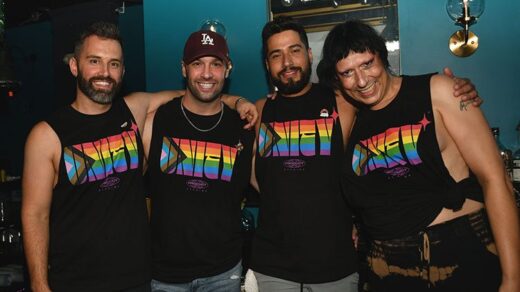How Instagram Created a Platform for Pride in a Pandemic
As stay-at-home orders and restrictions swept the United States in March, there was a growing realization in the LGBTQ+ community that Pride would no longer be in person.
That realization extended to brands as well. For Charles Porch, the vice president of global partnerships at Instagram, there was a “quick moment of mourning” that Pride would be “purely digital” this year. “Everyone had to reset their expectations,” he said.
However, Instagram, as a social media platform, was also uniquely situated to help facilitate a virtual space for LGBTQ+ gathering, visibility, celebration, and demonstration. And that’s what the company set out to do.
Over the past month, Instagram helped create this space by highlighting LGBTQ+ people and stories on the main Instagram account, with a reach of over 355 million followers. Celebrity AIDS activists Elton John and Jonathan Van Ness, painter Samuel Franca, photographer Texas Isaiah, and LGBTQ+ makeup artists were among those featured on the grid.
Additionally, Instagram partnered with the Trevor Project to create a well-being guide of self-care tips — a vital resource in a time when many are cut off from real-life support networks — with Brooklyn-based illustrator Ohni Lisle. Instagram Stories also added Pride stickers designed by LGBTQ+ artists to its features as well as an augmented-reality filter that allowed users to express 12 different LGBTQ+ identities.
For Porch, implementing these programs has helped bring the rainbow back to June. “Watching people celebrate through either their activism or telling their personal stories or creating incredible art has kind of gotten me through, and I’ve been marking Pride with all of those things,” he said.
Queerness has always been part of Instagram’s DNA, Porch said. Since its founding nearly a decade ago, the platform has drawn “a really active and very supportive LGBTQ community” in its user base and among its earliest employees, who have helped build features to support these users, he said.
Today, there is “a very vocal group and a very passionate group” at Instagram, he added, queering features like Instagram Stories, IGTV, and donations, which directly support in-need LGBTQ+ groups like the Trevor Project, the beneficiary of a recent live DJ set from Samantha Ronson.
Instagram is also now central to queer dating. Touted by Lizzo, “sliding into DMs” has become a signature feature of the platform, which appearance-wise can sometimes look like a dating app like Grindr, depending on one’s preferences and suggested content. Finding love, said Porch, has been a beneficial by-product of Instagram’s primary goal, which is building community and a safe space to be out online.
“Ideally, we’re helping show all the aspects of LGBTQ+ life. I think dating becomes a part of that naturally,” said Porch, adding, “I hear from people actually pretty regularly who met their spouse or their partner via Instagram, which is super inspiring. I think it’s a nice side effect there.”
And LGBTQ+ support is not limited to June. Porch wants Pride to happen on Instagram “all year long” by continuing to elevate LGBTQ+ artists, activists, and businesses. This is essential in a time of lockdown, said Porch, when it is “harder to make money” for many stores. The stickers will stick around for a little while longer too.
As powerful as Instagram is in raising the visibility of LGBTQ+ people and bringing the community together, however, the platform can also be exploited to promote hate speech, racism, and misinformation — at times from the highest levels of government. This misuse has sparked a boycott of Instagram and its parent company, Facebook, from influencers and advertisers alike.
Addressing these concerns, Porch said that “making the platform a safe space safe from harassment” is his and Instagram’s “number one priority.”
“We’re doing a lot of really hard work across Instagram on everything from hate speech and free speech to tackling harassment and harmful content,” Porch said. “And we have people around the world working on this 24 hours a day, in countries across the globe, across cultures and age groups.
“We are not perfect, and we adapt as we need to. And we have some of the best minds, the best people that really, really care about this working on this constantly. I just want to reassure everyone listening that we take it to heart and it’s our number one priority at all times.”
The recent Black Lives Matter demonstrations have also been “a turning pointing” for Instagram.
“Instagram has always been a platform for activism. But I think you really saw an explosion in the past month, which personally has been super inspiring for us,” Porch said. “And I think when we look at that we really come to it with two goals, right. The first is, how can we help people be antiracist? And how can we make sure that we as a company are antiracist?”
Regarding the first goal, Instagram is encouraging its users to #ShareBlackStories. Like its LGBTQ+ spotlights, Black activists and their stories are featured on the main Instagram account. Groups such as the Equal Justice Initiative are creating educational guides on subjects like the history of criminal justice in the U.S. — a feature that was initially intended for travel but was “pivoted” to support social justice movements, Porch said.
“And then internally, what we’re really focused on is making sure our products and our processes don’t reflect deep systemic biases that there are in society,” Porch said. “So that could be on anything from our algorithm or the process on how you get verified. And we’re really looking at all of that to make sure that things are as equal as possible.”
There are also steps individual Instagram users can take to fight injustice. A lot of this boils down to the basics of maintaining a successful Instagram account.
First, “use the platform authentically,” Porch recommended. “Show who you are, show where you are. That means you could be anything from an activist to an ally who wants to learn to someone who wants to raise a ton of money around a cause. Use it the way you would normally and in a way that can be as powerful as possible.”
Second, “experiment to see what works well,” he added. For example, some celebrities like Leslie Jordan opted to “pass the mic” to Black activists, using their own large platforms to elevate the voices of marginalized people. This movement “has been incredibly effective,” Porch said. “And it’s been amazing to see the takeovers that are coming out of that.”
Third, “connect with your community,” Porch said. “Talk to your friends and recruit people to help you get the word out across Instagram. I think the more we can get the message out across a number of accounts and the more we can normalize movements and the important things in the movement and get the word out, I think the better off we’ll be.”
Finally, “use all of the surfaces,” Porch said. “I often talk about Instagram like shelves in the store. You want to use all the things so use your feed, use stories, do an IGTV, try Live for the first time if you haven’t done it. Stock all those shelves so you’re getting the word out in as many ways as possible on the platform.”
Watch the conversation with Porch below.
Original Article on The Advocate
Author: Daniel Reynolds





